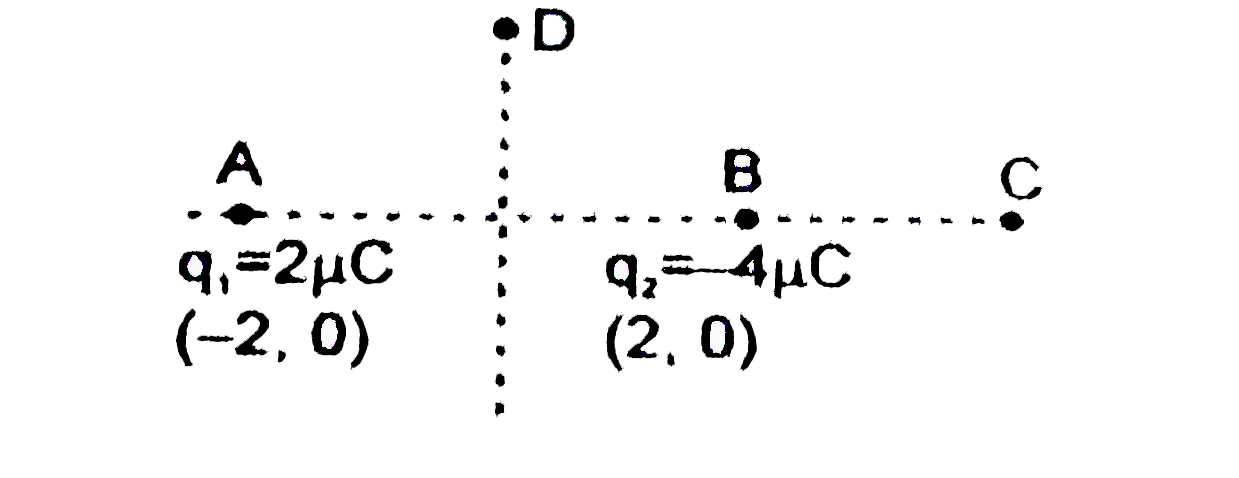Consider a system of two equal points charges, each Q=8μC, which are fixed at points (2m, 0 ) and (-2m, 0). Another charge μ is held at a point (0,0.1m) on the y-axis. Mass of the charge μ is 91 mg . At t= 0 , μ is released from rest and it is observed to oscillate along y-axis in a simple harmonic manner. It is also observed that at t = 0 , the force experienced by it is 9×10−3N.
Frequency of oscillation is
8
10
5
2
The correct Answer is:C
To solve the problem step by step, we will follow the given information and apply the relevant physics concepts.
Step 1: Understand the System
We have two equal point charges, each Q=8μC=8×10−6C, located at points (2,0) and (−2,0) on the x-axis. There is another charge μ with a mass of 91mg=91×10−6kg positioned at (0,0.1) on the y-axis.
Step 2: Calculate the Force on Charge μ
The force experienced by charge μ at (0,0.1) is given as F=9×10−3N.
Step 3: Determine the Acceleration
Using Newton's second law, we can find the acceleration a of charge μ:
a=Fm
Substituting the values:
a=9×10−3N91×10−6kg=9×10−391×10−6≈98.9m/s2
Step 4: Identify the Displacement
The displacement from the mean position (the equilibrium position on the y-axis) is given as y=0.1m.
Step 5: Calculate the Time Period of Oscillation
For simple harmonic motion, the time period T can be calculated using the formula:
T=2π√ya
Substituting the values of displacement and acceleration:
T=2π√0.198.9
Calculating the square root:
√0.198.9≈√0.00101≈0.0318
Now substituting back into the time period formula:
T≈2π×0.0318≈0.199
Step 6: Calculate the Frequency of Oscillation
The frequency f is the reciprocal of the time period:
f=1T≈10.199≈5.03Hz
Rounding off, we can say:
f≈5Hz
Final Answer
The frequency of oscillation is approximately 5Hz.
---
We have two equal point charges, each Q=8μC=8×10−6C, located at points (2,0) and (−2,0) on the x-axis. There is another charge μ with a mass of 91mg=91×10−6kg positioned at (0,0.1) on the y-axis.
The force experienced by charge μ at (0,0.1) is given as F=9×10−3N.
Using Newton's second law, we can find the acceleration a of charge μ:
a=Fm
Substituting the values:
a=9×10−3N91×10−6kg=9×10−391×10−6≈98.9m/s2
The displacement from the mean position (the equilibrium position on the y-axis) is given as y=0.1m.
For simple harmonic motion, the time period T can be calculated using the formula:
T=2π√ya
Substituting the values of displacement and acceleration:
T=2π√0.198.9
Calculating the square root:
√0.198.9≈√0.00101≈0.0318
Now substituting back into the time period formula:
T≈2π×0.0318≈0.199
The frequency f is the reciprocal of the time period:
f=1T≈10.199≈5.03Hz
Rounding off, we can say:
f≈5Hz
The frequency of oscillation is approximately 5Hz.
Topper's Solved these Questions
- MISCELLANEOUS VOLUME 3Book:CENGAGE PHYSICS ENGLISHChapter:MISCELLANEOUS VOLUME 3Exercise:Interger Answer type
Explore 20 Videos
- MISCELLANEOUS VOLUME 3Book:CENGAGE PHYSICS ENGLISHChapter:MISCELLANEOUS VOLUME 3Exercise:Fill in the blanks
Explore 10 Videos
- MISCELLANEOUS VOLUME 3Book:CENGAGE PHYSICS ENGLISHChapter:MISCELLANEOUS VOLUME 3Exercise:Assertion and Reason Type
Explore 8 Videos
- MAGNETIC FIELD AND MAGNETIC FORCESBook:CENGAGE PHYSICS ENGLISHChapter:MAGNETIC FIELD AND MAGNETIC FORCESExercise:Multiple Correct Answer type
Explore 2 Videos
- MISCELLANEOUS VOLUME 5Book:CENGAGE PHYSICS ENGLISHChapter:MISCELLANEOUS VOLUME 5Exercise:Integer
Explore 12 Videos
Similar Questions
Consider a system of two equal points charges, each Q=8μC, which are fixed at points (2m, 0 ) and (-2m, 0). Another charge μ is held at a point (0,0.1m) on the y-axis. Mass of the charge μ is 91 mg . At t= 0 , μ is released from rest and it is observed to oscillate along y-axis in a simple harmonic manner. It is also observed that at t = 0 , the force experienced by it is 9×10−3N.
Charge q is
View SolutionConsider a system of two equal points charges, each Q=8μC, which are fixed at points (2m, 0 ) and (-2m, 0). Another charge μ is held at a point (0,0.1m) on the y-axis. Mass of the charge μ is 91 mg . At t= 0 , μ is released from rest and it is observed to oscillate along y-axis in a simple harmonic manner. It is also observed that at t = 0 , the force experienced by it is 9×10−3N.
Amplitude of motion is
View SolutionConsider a system of two equal points charges, each Q=8μC, which are fixed at points (2m, 0 ) and (-2m, 0). Another charge μ is held at a point (0,0.1m) on the y-axis. Mass of the charge μ is 91 mg . At t= 0 , μ is released from rest and it is observed to oscillate along y-axis in a simple harmonic manner. It is also observed that at t = 0 , the force experienced by it is 9×10−3N.
Equation of SHM (displacement from mean position) can be expressed as
View SolutionTwo equal positive charges Q are fixed at points (a, 0) and (−a,0) on the x-axis. An opposite charge -q at rest is relased from point (0, a) on the y-axis. The charge -q will
View SolutionTwo equal negative charges −q are fixed at points (0,−a) and (0,a) on y-axis. A poistive charge Q is released from rest at point (2a,0) on the x-axis. The charge Q will
View SolutionTwo point charges q each are fixed at (a,0) and (-a,0). A third charge Q is placed at origin. Electrons potential energy of the system will
View Solutiontwo point charges 2μC and −4μC are situated at points (−2m,0m) and (2m,0m) respectively. Find out potential at point C(4m,0m) and D(0m,√5m).

View SolutionTwo small particles P and Q each of mass m are fixed along x-axis at points (a,0) and (-a,0). A third particle R is kept at origin. Then
View SolutionAs charge q=1μC is placed at point (1m,2m,4m). Find the electric field at point P(0,−4m,3m)
View SolutionTwo point charges −q and +q are located at points (0,0−a) and (0,0,a) respectively. The electric potential at point (0,0,z)is (Z>a)
View Solution
